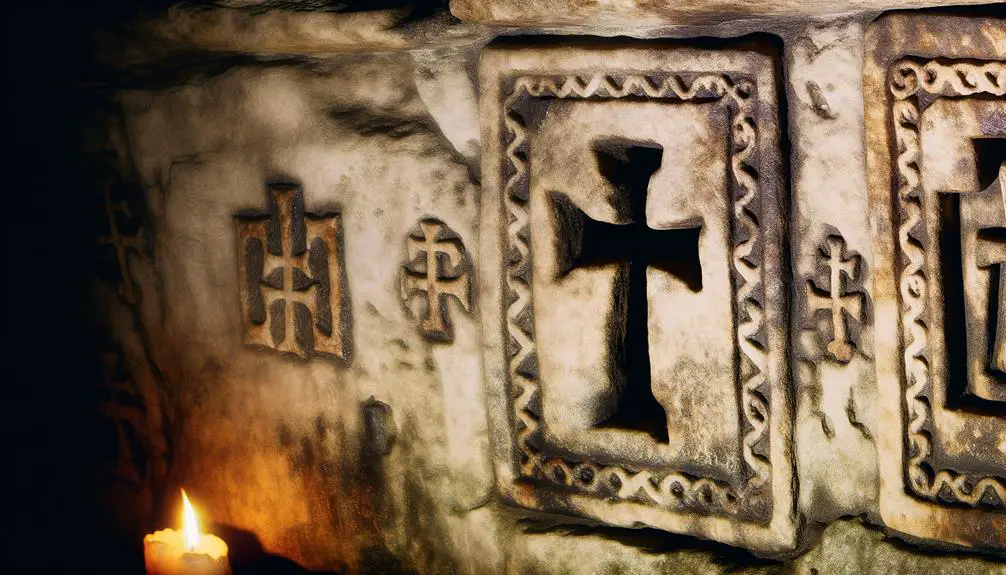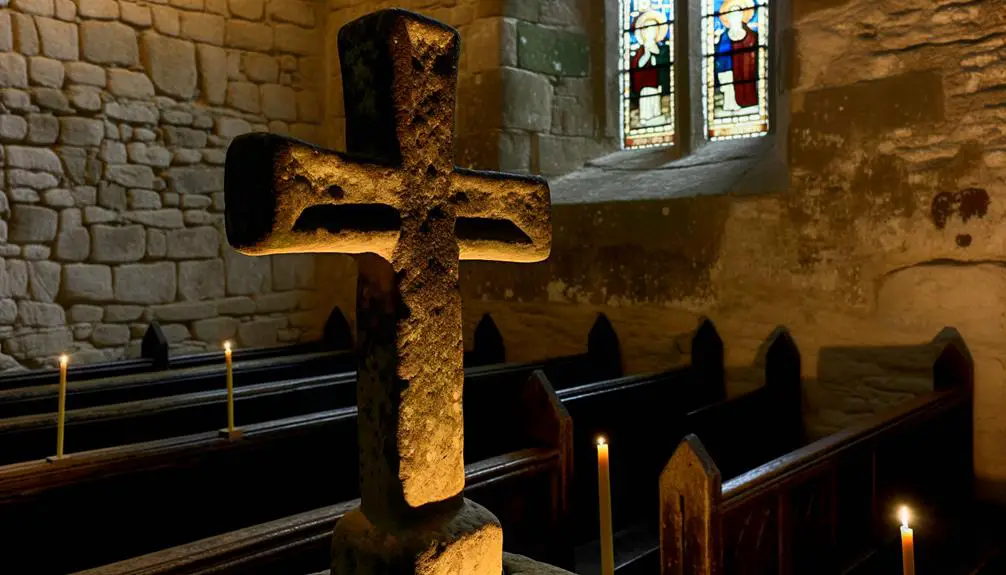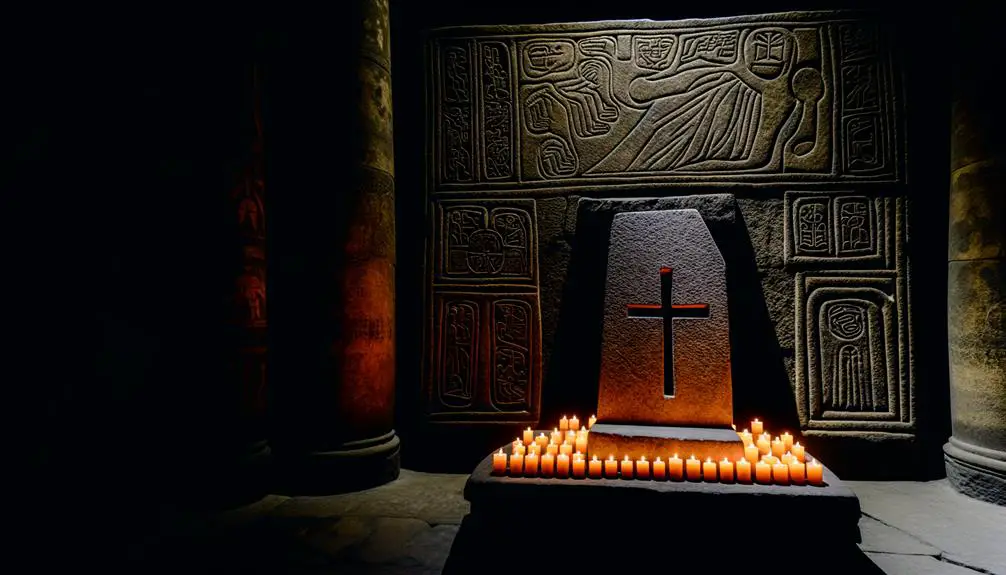What Does the Symbol of the Upside Down Cross Mean?
The upside down cross, historically linked to early Christian traditions, is chiefly associated with the martyrdom and humility of Saint Peter. Believed to have been crucified upside down at his own request, Saint Peter's inversion symbolized reverence and unworthiness compared to Christ.
This early Christian symbol has theological significance, reflecting spiritual humility. However, misconceptions have arisen due to media and cultural reinterpretations, leading to its modern association with anti-Christian sentiment and rebellion.
The symbol's usage spans various contexts, including Scandinavian folklore and contemporary media. To fully grasp its complex evolution across eras and cultures, consider exploring its diverse representations.

Key Takeaways
- Represents Saint Peter's crucifixion and humility in Christian theology.
- Holds historical significance in early Christian traditions and martyrdom.
- Often misunderstood and misappropriated by modern media and subcultures.
- Symbolizes defiance and rebellion in contemporary art and culture.
- Used to depict dark or supernatural themes in television series and video games.
Historical Origins

The historical origins of the upside down cross, also known as the inverted cross, can be traced back to early Christian traditions, particularly the martyrdom of Saint Peter. This symbol, however, predates its association with Peter and can be found in various ancient cultures, serving different symbolic functions.
Within the Christian context, the emblem emerged as a profound reflection of humility and unworthiness, subverting the conventional cruciform. The inverted cross also appears in ecclesiastical heraldry and iconography, reflecting theological nuances unique to early Christianity. Such usage underscores its complex semiotic evolution.
The emblem's historical trajectory reveals a rich tapestry of religious and cultural intersections, highlighting its role as a symbol of piety rather than its contemporary misinterpretations.
Saint Peter's Martyrdom
Saint Peter's martyrdom is traditionally believed to have occurred through crucifixion upside down at his own request. This act holds profound theological and historical significance, often interpreted as a symbol of humility and unworthiness in comparison to Jesus Christ. Understanding the historical context of Saint Peter's crucifixion is essential for comprehending the development of the upside-down cross symbol within Christian iconography.
Saint Peter's Crucifixion
In early Christian tradition, the crucifixion of Peter holds significant theological and symbolic weight, particularly as he was crucified upside down at his own request. This act, according to apocryphal texts, was driven by his sense of unworthiness to die in the same manner as Jesus Christ.
The inversion of the cross not only highlights Peter's humility but also serves as an emblematic gesture deeply embedded in Christian iconography. This unique crucifixion underscores Peter's pivotal role among the Apostles and his profound devotion to Christ's teachings.
The upside-down cross consequently emerges as a complex symbol within Christianity, representing both profound reverence for Christ and the distinct, sacrificial identity of Saint Peter.
Historical Context Significance
Peter's martyrdom, occurring during Nero's persecution of Christians in the mid-first century, offers profound insights into the early Church's trials and the complex interplay between Roman authority and burgeoning Christian faith. His choice to be crucified upside down, deeming himself unworthy to die as Jesus did, underscores the humility and fervent devotion characteristic of early Christian leaders.
This act also highlighted the brutal methods employed by Roman authorities to suppress dissent. The upside-down cross thereby became a poignant symbol, reflecting both the persecution faced by early Christians and their steadfastness. It serves as a historical testament to the resilience and profound spiritual convictions that underpinned the nascent Christian community amidst severe external pressures.
Christian Interpretations

Within Christian theology, the upside down cross is primarily associated with the crucifixion of Saint Peter, who, according to tradition, requested to be crucified in this manner to express his humility and sense of unworthiness in comparison to Jesus Christ.
This interpretation underscores the symbol's roots in profound acts of faith and humility. Consequently, the upside down cross serves as a poignant representation of the virtue of humility within the Christian faith.
St. Peter's Crucifixion
Although often misconstrued, the upside-down cross, or St. Peter's Cross, holds significant meaning within Christian traditions, symbolizing the apostle Peter's humility and martyrdom.
Tradition asserts that Peter, one of Jesus Christ's foremost disciples, chose to be crucified upside down, deeming himself unworthy to die in the same manner as his Lord. This act of inverted crucifixion is not merely a historical footnote but a profound theological statement. It underscores Peter's deep sense of reverence and unworthiness, contrasting his human frailties with Christ's sanctity.
Early Christian texts, such as the apocryphal Acts of Peter, provide context for this narrative, further embedding the upside-down cross within the rich tapestry of Christian martyrdom and iconography.
Humility and Unworthiness Symbol
In Christian theology, the upside-down cross serves as a poignant emblem of humility and unworthiness, deeply rooted in the narrative of St. Peter's martyrdom. According to tradition, St. Peter requested to be crucified upside down, feeling unworthy to die in the same manner as Jesus Christ. This profound act symbolizes the Christian virtues of humility and self-abasement, illustrating a powerful theological statement.
| Concept | Symbolism | Contextual Meaning |
|---|---|---|
| Humility | Upside-down Cross | Reflects St. Peter's request and sense of unworthiness |
| Unworthiness | Upside-down Crucifixion | Peter's deference to Jesus' superior sacrifice |
| Theological Virtue | Inverted Cross Representation | Emphasizes Christian ideals of humility and sacrifice |
This interpretation underscores a broader Christian ethos, reinforcing the belief in spiritual humility before divine authority.
Modern Misconceptions
How did the upside down cross come to be widely misunderstood as a symbol of evil and anti-Christian sentiment in modern times? This misconception can be traced to several factors:
- Media Influence: Horror films and popular culture often depict the upside down cross as a symbol of satanic rituals.
- Lack of Historical Awareness: Many are unaware of its origins as a symbol of Saint Peter's humility in Christian tradition.
- Misappropriation by Subcultures: Certain anti-establishment groups have adopted the symbol to signify rebellion against mainstream Christianity.
- Internet Proliferation: Online misinformation has contributed to the spread of incorrect interpretations.
Understanding these factors provides a thorough view of why the upside down cross is misinterpreted, contrasting its original, more nuanced meaning.
Cultural Representations

Across various cultures, the upside down cross has been depicted in diverse contexts that reflect a range of beliefs and values. Historically associated with St. Peter's crucifixion, the symbol was revered for its humility. In contrast, some contemporary subcultures have repurposed it, infusing new meanings often antithetical to its original context. This duality underscores the symbol's cultural versatility.
| Culture | Interpretation |
|---|---|
| Early Christianity | Martyrdom and humility |
| Gothic Subculture | Rebellion and nonconformity |
| Scandinavian Folk | Protective amulet against evil |
| Japanese Media | Element of shock and horror |
Such representations reveal the symbol's capacity to traverse cultural boundaries, adapting to varied ideological frameworks. Understanding these contexts enriches our comprehension of its multifaceted significance.
Symbolism in Media
The upside down cross has emerged as a potent symbol in various forms of media, often employed to evoke themes of transgression, subversion, and the uncanny. This symbol's utilization spans diverse genres and mediums, frequently appearing in contexts designed to challenge conventional norms and provoke thought.
Its presence is particularly notable in the following areas:
- Horror Films: Utilized to signify malevolent forces or diabolical influence.
- Music Videos: Employed by artists to project a rebellious or anti-establishment image.
- Television Series: Featured in storylines to explore themes of moral ambiguity and conflict.
- Video Games: Incorporated as a visual cue to indicate dark or supernatural elements.
These varied applications underscore the versatility of the upside down cross as a symbol rich with complex meanings and cultural resonance.
Conclusion
The symbol of the upside-down cross is a complex tapestry woven from historical threads, theological interpretations, and modern misconceptions. Saint Peter's martyrdom imbued it with an aura of humility and sacrifice, yet contemporary depictions often obscure this lineage.
In media and culture, the symbol oscillates between reverence and rebellion, reflecting broader societal tensions. Consequently, the upside-down cross stands as proof of the evolving interplay between tradition and reinterpretation.






